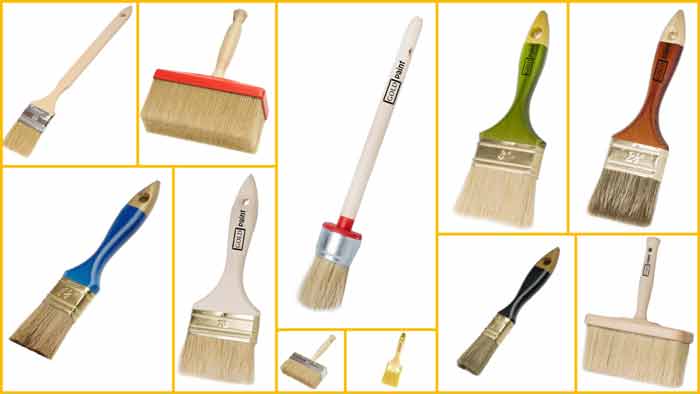 In many works, reaching for the brush is a matter of course. Whether for applying colors, Lacquers and glazes, Choosing the right tool is crucial for the work result. Therefore, here is the topic of brushes for you as tiny as a hair.
In many works, reaching for the brush is a matter of course. Whether for applying colors, Lacquers and glazes, Choosing the right tool is crucial for the work result. Therefore, here is the topic of brushes for you as tiny as a hair.
Two factors determine the choice of brush: What you want to delete (object) and with what (paint). Form – round, flat, angled – and size depend on the item. applies: The larger the area, the bigger the brush. The nature of the bristles – also called cutlery – depends on the paint. Natural bristles are best suited for solvent-based varnishes and paints, Synthetic fiber bristles are correct for water-based paints. In detail:
FOR SYNTHETIC RESIN PAINTS
Oil-based paints work best with natural bristles. The secret of the so-called Chinese bristles used in this process lies in their structure. The material comes from Chinese pigs, whose scaly surface accepts paint well and with its spliced tip (banner) equally distributed. To the brush shapes: Round a Ämnden and held together with a ring form the bristle jjf (dark or light) the classic round- or ring brush (1). Its advantages are particularly evident on curved surfaces (Tube) out of. Es gibt ihn in vielen Größen und meist mit Rohholzstiel. At the flat brush (2), ideal for painting larger areas, a metal clamp holds the bristles together. There are several handle variants for lacquer brushes of this shape: Rohholz, Painted or coated with plastic The oval brush combines a round and flat shape (3), here with a plastic handle. The flat sweeper (4) with the strong, short raw wood handle makes no secret of its area of responsibility. Hard-to-reach places (corners, radiator) reaches the angle brush (5). Edge-precise work is carried out with the flat brush (6) out of. It has a long, flat handle.
FOR ACRYLIC PAINTS
With water-based paints, pure natural bristles reach their limits, Because they swell and then become unstable. This is where brushes in many shapes and sizes with exclusively or predominantly synthetic bristles show their advantages (16 – 19). Synthetic fibers can now be manufactured in almost any shape. your profiles (cross sections) turn out very differently. Brush manufacturers use both hollow fibers and full profile ones (for example the X-profile, Drawing on the front). The tips (flags) are slit down to the finest hair and are therefore similar to pig bristles.
FOR WALL COATINGS
With brushes for wall painting (facade painter, 9) the natural bristle still reigns supreme, usually the strong gray variant. Around- and flat brushes are used less, on the other hand, hardly any renovation work can be done without the angled corner brush (8, below) do. Also ceiling brush (7) and surface wipers (9) are trusted helpers.
FOR GLAZES
A mixture of synthetic fibers and Chinese bristles is best suited for processing this rather thin paint. As a rule, flat brushes are used (12 + 10, above). For larger volumes, use the flat brush (11). But the special bristle mixture for glazes is also available in all common forms, several sizes and for special cases, for example window bars (22).
SPECIALISTS
Some prank media (wax, stain) or special tasks (window bars, stencils) require special brushes. paint: By the wax brush (13) a plastic ferrule holds a mix of different synthetic bristles (flatter) Form. Ammonia-based stains must not come into contact with metal. That's why the strong gray China bristles of the pickling brush (14) held with a plastic clamp. Only the completely metal-free brush is suitable for aggressive paint removers (15) in question – with strong nylon bristles in just one size. special tasks: Optimum lines when painting windows are achieved with a flat island cut at an angle (21) – depending on the paint with different bristles – or the round acrylic paint version with a mix of polyester fibers and china bristles (22). The sprout brush - made of light China bristles – is ideal for fine bracing. Its tapering shape is available with different cutlery. Sharp demarcations succeed with the slash puller (20) made of black Chinese bristles. The stencil brush (23, light China bristle), Specialist in decor work, used to dab stencils.